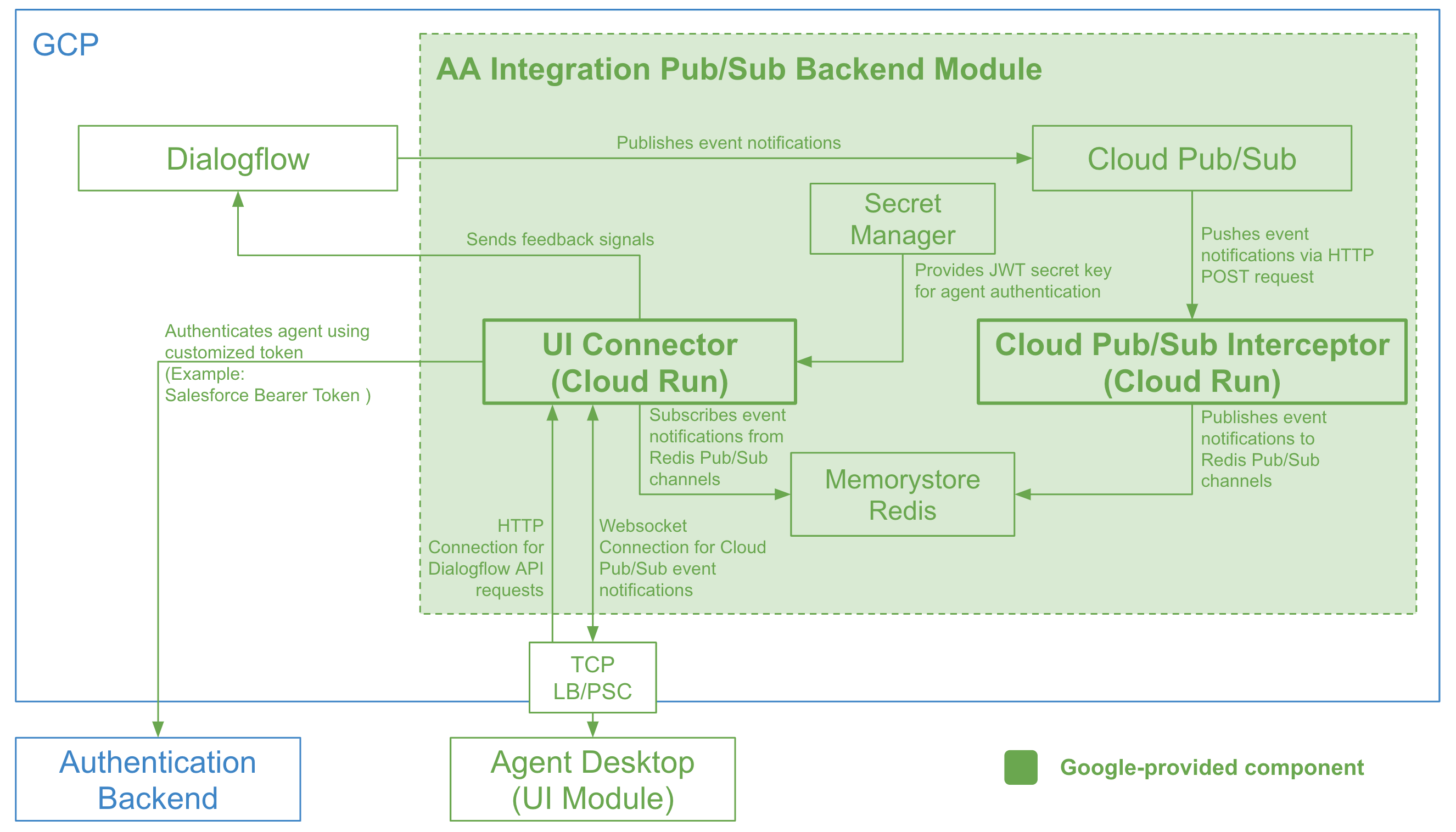Agent Assist now offers backend modules, an out-of-the-box option for integrating Agent Assist into your system. Backend modules includes a Cloud Pub/Sub interceptor service and a UI connector service. The interceptor processes feature-related event notifications from Dialogflow using Cloud Pub/Sub topics and then the UI connector pushes them to the agent desktop UI. UI connectors also support feedback signals from the agent desktop and sends them to Dialogflow.
Backend modules structure

Backend module components
Backend modules require the following Google products to integrate Agent Assist into your system:
- Cloud Pub/Sub
- Cloud Pub/Sub interceptor
- Memorystore for Redis
- UI connector
Cloud Pub/Sub
Cloud Pub/Sub topics are configured in
conversation profiles.
Agent Assist will then publish suggestions, new messages, new recognition-result notifications, and conversation
lifecycle-related events to the topic. Suggestions are in the form of
HumanAgentAssistantEvent,
and both new messages and conversation lifecycle events in the form of
ConversationEvent.
For each conversation profile, these four kinds of event messages are published
to different topics. For example, a conversation lifecycle event message might
be {"conversation":"projects/your-project-id/locations/global/conversations/your-conversation-id","type":"CONVERSATION_STARTED"},
which indicates the start of a conversation.
Cloud Pub/Sub interceptor
The Cloud Pub/Sub interceptor is deployed on Cloud Run. The functionality of each container instance (server) of this Cloud Run service is identical to each other instance, including:
- Processing event messages posted by Cloud Pub/Sub topics using HTTP requests.
- Publishing messages received to Redis Pub/Sub channels, specific to the
conversation name and the UI connector server ID. The channel format is
{connector_id}:{conversation_name}.
Redis
Redis uses Memorystore for Redis to do the following:
- Record the UI connector server ID information for each conversation in mapping
<conversation_name, connector_id>. - Forward event notifications published by Cloud Pub/Sub interceptor to the corresponding UI connector server using the Redis Pub/Sub mechanism.
UI connector
UI connector is an application that exposes a RESTful Dialogflow API
proxy and a SocketIO WebSocket endpoint to stream Dialogflow messages
originating from Agent Assist.
UI connector is deployed on Cloud Run.
Because WebSocket connections are stateful, the agent desktop will stay
connected to the same container on Cloud Run throughout the lifespan of the
connection. Therefore, every UI connector server handles different conversations
and subscribes to distinct Redis Pub/Sub channels ({connector_id}:*) for the
conversations they handle. Tasks for each UI connector server:
- Supports a customized authentication method for agent desktops.
- Generates temporary JWT after authenticating agent desktops' customized tokens. When they send requests to the Dialogflow API or WebSocket connection, UI connectors validate the attached JWT instead of checking the original agent token.
- Establishes a SocketIO WebSocket connection with the authenticated agent desktop based on a given conversation name.
- Subscribes event messages to Redis Pub/Sub channels for the conversations it handles.
- Pushes Agent Assist events to the desktop UI as they are received.
Secret Manager
The UI connector needs a JWT secret key to generate temporary JWTs for authenticated agent desktops. This secret key is stored in the Secret Manager.
Directory
The following is an outline of directory structure in the code repository. Contact your Google representative for permissions if you are not able to access the repository.
.
├── cloud-pubsub-interceptor
│ ├── Dockerfile: Docker-image creation for Cloud Pub/Sub Interceptor deployment on Cloud Run
│ ├── main.py: A starter for flask app
│ ├── requirements.txt: Python packages for running Cloud Pub/Sub Interceptor service
│ └── unit_test.py: Unit test code for Cloud Pub/Sub Interceptor
├── cloudbuild.yaml: An example configuration file for Cloud Build
├── deploy.sh: An automated deployment script
├── images
├── readme.md
└── ui-connector
├── Dockerfile: Builds Docker image for UI Connector deployment on Cloud Run
├── auth.py: JWT validation and registration handling
├── auth_options.py: Support for authentication through different identity providers
├── config.py: Configuration for variables about authentication, logging, and CORS origins
├── dialogflow.py: With Dialogflow utilities for runtime-conversation handling
├── main.py: A starter for flask app
├── requirements.txt: Python packages for running UI Connector
├── templates
│ └── index.html: A simple interactive demo
└── unit_test.py: Unit test code for UI Connector
Pricing and quotas
Agent Assist integrations include the following services, which have their own applicable pricing and quota limits.
- Agent Assist prices and quotas
- Pub/Sub prices and quotas
- Memorystore prices and quotas
- Cloud Run prices and quotas
What's next
See the backend modules installation guide for more information about getting started with this integration method.
